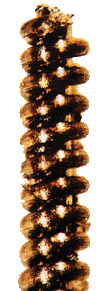Read the information about these sensational findings, and have a look at the photographs.
This case has been studied by Hartwig Hausdorf. Mr. Hausdorf has a travel company which enables him to travel extensively, often to places not normally accessible to foreigners. Recently he was in a remote part of China where there are a large number of pyramids. His book THE CHINESE ROSWELL about the famous Dropa UFO crash in ancient China is published by New Paradigm Books, Boca Raton, FL. (Contact John Chambers, jdc@flinet.com)
|
Figure 1 - Example of micro-artefact found in the Urals. Click on picture for larger image. |
The discovery, about a year ago, of possibly-extraterrestrial nano-artefacts from the upper Pleistocene in the Ural mountains, led to violent arguments. Are these really remnants of some unearthly technology, or merely industrial waste from our own times? The present report, by the Central Scientific Research Institute for Geology and Prospecting for Precious and Non-Ferrous Metals (ZNIGRI) in Moscow, which has now been translated into German, emphasises the possibility of an extraterrestrial origin.
In my book WENN GOETTER GOTT SPIELEN (When Gods play God) [1] as also in Ancient Skies [2], I reported an unbelievable find of numerous metallic artefacts in Russia. I was told from several quarters that such objects simply couldn't exist, and that I had been carried away by my imagination. But now, new visual material, and a translation of a laboratory report from Moscow by a sworn translator, support my conclusion that we are here dealing with possible technical artefacts of extraterrestrial origin.
Let's recapitulate: since 1991, more and more mostly spiral-shaped objects have been found, on the banks of the rivers Narada, Kozim, and Balbanyu in the eastern Ural mountains. They are composed principally of tungsten, molybdenum, and copper [1, 2]. It was extremely fortunate that these discoveries were made in the course of official exploration. The expeditions were mounted with a view to exploiting precious and non-ferrous metals in this regions, and geological and mineralogical analyses were carried out. The work was under the auspices of the Central Scientific Research Institute for Geology and Prospecting for Precious and Non-Ferrous Metals (ZNIGRI) in Moscow, which comes under the Committee of the Russian Federation for Geology and Exploitation of Mineral Resources.
As I was told by Dr. Valerii Ouvarov (St. Petersburg), further analyses of the mysterious spirals were carried out by the out-stations of the Russian Academy of Sciences in St. Petersburg and in Syktyvar (former capital of the Komi ASSR), and also at an independent institute in Helsinki.
I have before me the Expertise No. 18/485 of 29th November 1996, by the aforementioned Institute (ZNIGRI) [3], the original Russian text of which I reproduced in my book WENN GOETTER GOTT SPIELEN. Due to the short time before the book went to press, a correct and complete translation was not possible. This was only possible after a sworn translator had been brought in [4].
The author of the Expertise is Scientific Assistant Mme. Dr. E. W. Matveyeva, of the Section for Geology, Prospecting Techniques, and Economics of Precious Metal Alluvial Deposits. She reports first on the development of the discovery site, then the testing procedures used for the analysis of the thread-shaped tungsten spirals in the alluvial deposits of the Balbanyu river. The exact location of the site is given by ZNIGRI as follows: it is a development in the alluvial deposits of the third flood-terrace on the (looking downstream) left bank of the river Balbanyu, oriented along borehole line no. 106. Loose sediments are found in this development, which are represented as follows, working upwards from the oldest to the youngest deposits:
In the geological time-scale, the Pleistocene is that part of the Quaternary, the latest geological epoch, which began about 2 million years ago and ended around 10,000 years ago. After that followed the Holocene, in which we are at the moment.
The report continues by describing the tests carried out, which include the use of an electron microscope type JSM T-330 made by the Japanese firm Jeol. This also yielded data of various spectroscopic analyses [5].
| Figure 2 - Example of micro-artefact found in the Urals. Click on picture for larger image. |  |
Particular attention should be paid to the final conclusion reached by the Moscow institute. Report No. 18/485 states that the age of the deposits and the results of the tests give a very low probability to the assumption that the origin of these unusual, thread-shaped tungsten crystals is of a technogenic cosmic nature, due to the rocket take-off route from the Plesetsk space-station over the polar part of the Ural region.
In plain language: these objects cannot have originated from earlier test rockets or similar fired from Plesetsk. The key word of the report comes finally to the point: the data obtained allow the possibility of an extra-terrestrial technogenic origin.[3]
In view of these conclusions, critics will find it very difficult to accuse me of pseudo-documentatio nor embarrassing behaviour. On the contrary: I will try to obtain further investigation reports from the independent Finnish research institute, on which greater value might be placed.
My hypothesis is that these artefacts are so-called nano-technology, which I can sustain with reference to a recent publication [6]. Researchers all over the world are working on miniature pistons, gear wheels, switches, and other control elements, to be used in nano-robots. These workers will soon be in a position to achieve results which hitherto have been the province of science fiction.
Surely the last word has not yet been said about the sensational finds in the Ural mountains!